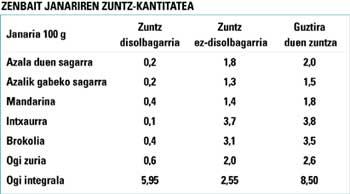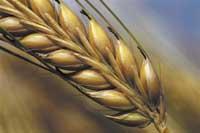Fiber to clean intestines

The fiber we can find in food can be of two types. Soluble fibers (pectin, gums and mucilage) form high viscosity gels when mixed with water. Fruits, vegetables and green beans have this type of fiber. Non-soluble fibers (cellulose, hemicellulose and lignin) do not absorb water. Mainly in cereals and nuts.
Fiber, in addition to being effective against constipation, has several benefits:
- Soluble fiber occupies more, increases stomach emptying time and considerably increases food bolus.
- It reduces blood cholesterol levels, hinders the absorption of fats from food and helps eliminate bile salts.
- It makes glucose absorption difficult, so it helps control blood glucose.
- It increases beneficial intestinal bacteria and helps eliminate harmful bacteria.
Numerous studies have shown that fiber helps protect hypercholesterolemia, diabetes, constipation, obesity, large bowel disease, and some types of cancer. In developed countries we consume 15-20% less fiber than recommended. The ideal measure for adults is 25-35 g of fiber a day.

In childhood, for every kilo the child weighs, it should take 0.5 g of fiber, and from three years of age, plus five grams of fiber a day. To meet these needs it is recommended to consume every day 6 servings of bread, rice, cereals, pasta or potato and 5 servings of vegetables, fruit or pod.
If we take large amounts of fiber in a day we can have winds and diarrhea, so we must slowly increase the amount of fiber until reaching 35g/day.
On the other hand, if a lot of fiber is ingested, calcium, iron and other mineral salts and vitamins are more difficult to absorb, but for this it is necessary to take at least 50 g of fiber a day. Finally, if some fibrous additive is taken, it is essential that it be taken with water for two reasons: on the one hand, to take more advantage of the benefits of fiber and on the other, to prevent it from accumulating in the intestine.

Whole foods
The reputation of whole foods is growing. For decades they were marginalized under the excuse of their low quality; it seemed that refined foods were more refined and better for health. Forty years ago fiber was not considered as nutrients, it was not considered useful for the body. But today we know that was corrupt; whole foods increasingly see more advantages in the investigations being conducted. The most comprehensive foods we can find are rice, pasta, whole-wheat bread, pastries, breakfast cereals, cookies, etc.
Whole foods contain more nutrients, more fiber, B and E vitamins, and more mineral salt than refined foods, such as selenium, zinc, iron, and magnesium. The reason is very simple: having not undergone a refining process, the original food is more respected. For example, whole wheat flour is obtained by adding to the white flour the natural dandruff of wheat, formed by the outer layers of wheat. Dandruff, in addition to fiber, contains vitamins from the sun, such as vitamin B1 or thiamine, essential for the use of carbohydrates. Refined flour contains much less thiamine, so in order to take advantage of the starch containing flour, it is essential that the body obtain this vitamin from another food. However, with bread made with whole wheat flour, breakfast cereals, etc. does not happen so, so it is said that they are balanced foods.

Another advantage of whole foods is that, being stronger in its structure, we chew more in the mouth, something essential for carbohydrate metabolism. The saliva ptialine enzyme begins to break the long carbohydrate chains, so these nutrients are digested much better in the intestine. If we accustom children from young to whole foods, in the future they will make a clear bet for them, because they will seem much tastier. In addition, when preparing them need less salt and less sugars.
Although there are many contrary opinions, it seems that the amount of energy offered by whole foods is similar to that of refined foods, with small differences. Therefore, the use of whole foods in the slimming excuse makes no sense, taking into account the amount of calories. Another aspect to keep in mind is that the greater amount of fiber in whole foods facilitates saturation with less food.
There is another known meal we have not mentioned in this group: cane sugar or brown sugar. Compared to white sugar derived from beet, it has the advantages of whole foods. However, sugar, whether white or black, is a simple carbon hydrate and must be taken carefully to avoid imbalances.
Therefore, turning whole foods into a daily habit is very good, but it is advisable to make the change gradually to avoid problems derived from fiber: the wind, the pain of the gut and in some cases the diarrhea. The body has to adapt, especially the intestines, and to achieve this we have to go taking small amounts every day, until the whole foods become everyday.





